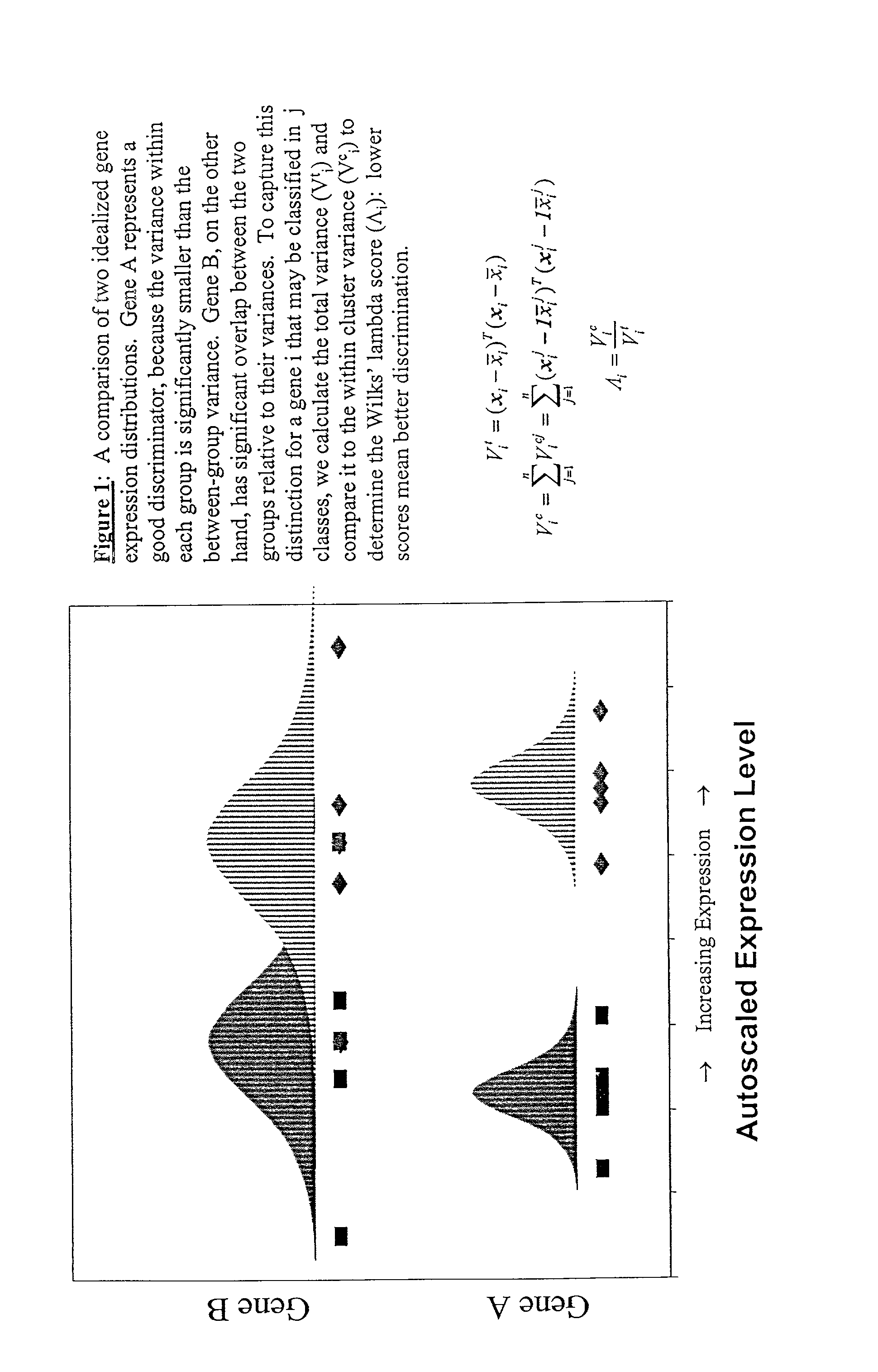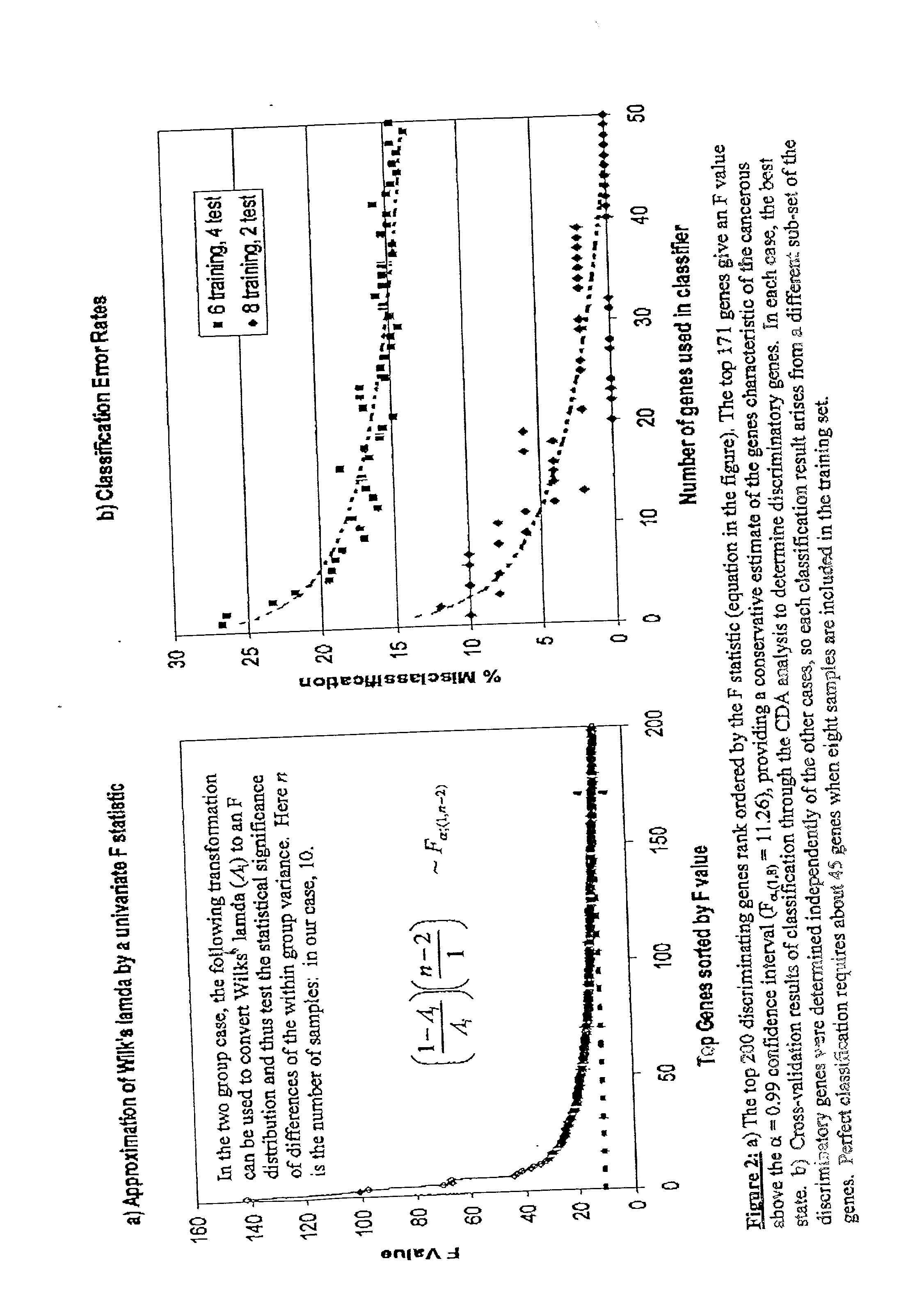Defining biological states and related genes, proteins and patterns
a technology of applied in the field of defining biological states and related genes, proteins and patterns, can solve the problems of poor dental hygiene, unfavorable use of data, and painless areas, and achieve the effect of reducing the effect of single base mismatch on overall duplex stability and increasing the length of the homology region
- Summary
- Abstract
- Description
- Claims
- Application Information
AI Technical Summary
Benefits of technology
Problems solved by technology
Method used
Image
Examples
example 1
Synechocystis Light / Dark Gene Regulation
[0301] We applied FDA projections to four examples of gene expression phenotypes generated in our laboratory and also published in the literature. In the first example, cultures of the photosynthetic bacterium Synechocystis sp. PCC 6803 were cultivated through an initial period of 48 hours of growth under light followed by 24 hours of darkness. The cultures where then cycled between light and dark conditions for 100 minutes each (FIG. 4). The expression levels of 88 genes associated with harvesting of light energy and central carbon metabolism were measured at 23 time points (29 total samples, including duplicates) using DNA microarrays. Gill, R. T., E. Katsoulakis, W. Schmitt, G. Taroncher-Oldenburg and G. Stephanopoulos, "Dynamic transcriptional profiling of the light to dark transition in Synechocystis sp. PCC6803," (submitted) (2000). Total signal to noise ratio of the microarray fluorescence was determined to be c.a. 4.0 indicating that b...
example 2
Oral Epithelial Cancer
[0302] To help elucidate the genetic and biochemical mechanisms underlying the onset of oral epithelium cancer, the expression phenotype (transcriptome) of oral epithelium was probed using expression microarrays, specifically the Affymetrix HuGeneFL.RTM. microarray containing .about.7000 human genes. The accuracy of the measured expression levels has been assessed to be approximately 82%, so that meaningful gene induction and repression differences can be thus monitored. I. Alevizos et al., submitted (2000); H. Ohyama et al., Biotechniques 29, 530-6 (2000). Although microarrays provide a vast amount of information about the state of transcription in cells and tissues, they are best taken advantage of when complemented by appropriate bioinformatic methods for the extraction of useful biological knowledge and the overall upgrade of their information content. We illustrate below the application of two such methods and have succeeded in identifying 45 genes that ar...
example 3
Acute Lymphoblastic Leukemia (ALL) and Acute Myeloid Leukemia (AML)
[0319] As another example, FDA projections were applied to the expression phenotypes measured in samples from patients with acute lymphoblastic leukemia (ALL) and acute myeloid leukemia (AML). Additionally, the ALL samples were further subdivided into B-lineage ALL and T-lineage ALL (B-ALL and T-ALL, respectively.) Golub, T. R., D. K. Slonim, P. Tamayo, C. Huard, M. Gaasenbeek, J. P. Meslrov, H. Coller, M. L. Loh, J. R. Downing, M. A. Caligiurl, C. D. Bloomfield and E. S. Lander, "Molecular classification of cancer: Class discovery and class prediction by gene expression monitoring." Science, 286, 531-537, (1999). To reduce the number of genes considered, the Wilks' lambda measure was used again to uncover those genes that provide significant discrimination among the three classes at the 99% confidence level. 1226 genes met this criterion of which 50 genes were selected for use in the FDA projection based on the erro...
PUM
| Property | Measurement | Unit |
|---|---|---|
| weight | aaaaa | aaaaa |
| area | aaaaa | aaaaa |
| Tm | aaaaa | aaaaa |
Abstract
Description
Claims
Application Information
 Login to View More
Login to View More - R&D
- Intellectual Property
- Life Sciences
- Materials
- Tech Scout
- Unparalleled Data Quality
- Higher Quality Content
- 60% Fewer Hallucinations
Browse by: Latest US Patents, China's latest patents, Technical Efficacy Thesaurus, Application Domain, Technology Topic, Popular Technical Reports.
© 2025 PatSnap. All rights reserved.Legal|Privacy policy|Modern Slavery Act Transparency Statement|Sitemap|About US| Contact US: help@patsnap.com



